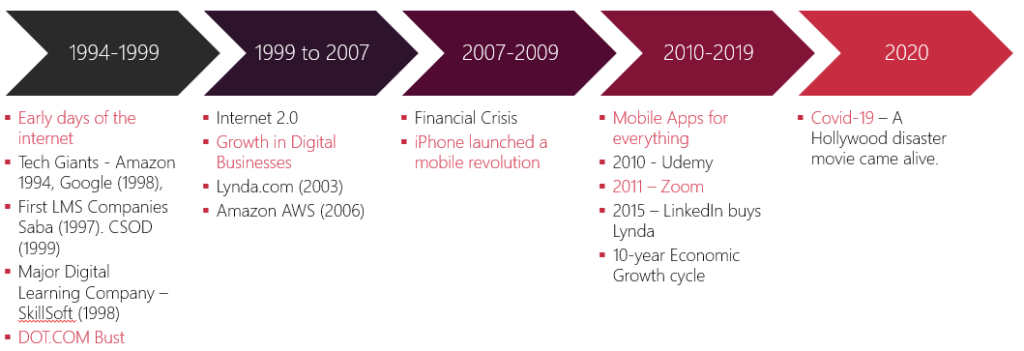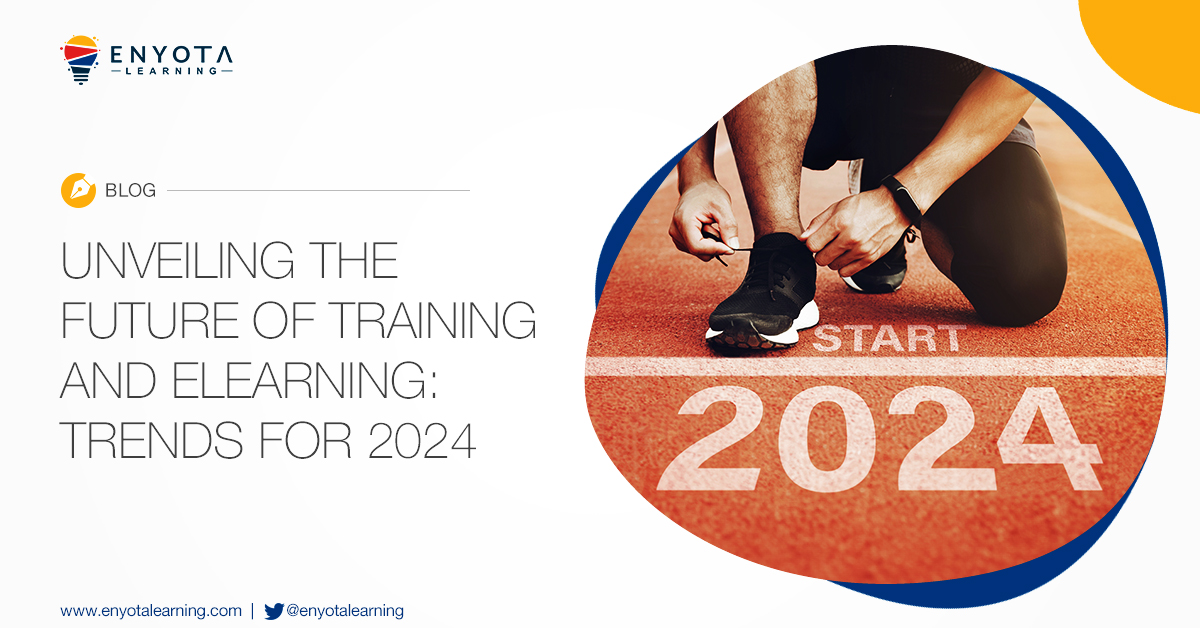What this article covers
- The pace at which digital transformation is progressing
- Stats with regards to face-to-face training during the pandemic
- Challenges of moving from classroom training to eLearning
- Our services with regards to custom eLearning development and assistance with taking your training online
A progress timeline of the digital transformation in the last 25 years
In the midst of everything digital is training. Now more than ever, while businesses relook at their offerings and services to cater to a reshaped consumer base, L&D teams must consider how to cater to a reshaped workforce that is functioning virtually with little to no access to on-demand training.
This article uncovers the challenges of converting classroom training to eLearning or digital training.

Let us look at a few stats with regards to face-to-face training in the pandemic era
- Close to 40% of the organizations that had organized face-to-face training initiatives just before COVID-19 are in a dire situation right now.
- 58% of respondents are still in flux — either in the process of developing or revising their L&D plan or just not confident in their ability to execute it.COVID-19 has negatively impacted the training budgets of over 58% organizations globally.
- Brandon Hall states that by mid-June 2020, 68% of organizations were turning to eLearning as a sustainable alternative to face-to-face learning. It also states that eLearning requires 40 to 60% less employee time than classroom training!
- The former CLO of Microsoft, Chris Pirie, told Forbes the following, “business leaders must find new ways to create engaging experiences which are experiential and fun. That means incorporating more gamification, virtual reality, and augmented reality for corporate learning.
So, What Makes the Transformation to Digital Training So Daunting?
As pointed out before, many organizations are stuck in the midst of their migration from traditional to modern training. Some are stuck because of the investment in face-to-face training. This is despite the early indications that eLearning was the way to go. Others are stuck owing to the budget cuts brought upon by the pandemic. Others aren’t really sure which option is for them, and with all the information available online, it can get confusing. However, moving to eLearning from traditional training is not a daunting task when you ask the right questions and engage with the right design partner who will help you with this transition.
Let us breakdown the five main aspects you need to consider that will make the transformation of classroom training to eLearning as easy as pie!
Budgets and Execution
The first important thing to consider are your budgets. Technically, implementing a traditional training event seems simpler and more cost-effective. After all, how difficult is it to book a venue, hire a trainer, and fix the logistics of traveling learners? But these are repetitive costs that can be eliminated when you opt for eLearning – one-time investment and reap the benefits over years to come! It is a common misconception that there are greater expenses associated with eLearning implementation. But compare that to the cost of hiring a venue, traveling staff, boarding and lodging fees, hiring a traveling trainer, and a whole lot more, and you will realize that it is much more affordable.
The learning curve involved with eLearning might seem long, but it is a one-time thing. Once you get over it as an organization, it is easy and effortless like everything that is digital and online. Afterall, is not ease in operability and savings in effort the prime objectives of technology?
Target Audience
The pandemic has made the impossible possible – most organizations have gone completely virtual. While others are considering a mix of both worlds, there is no denying that work-from-home is here to stay. Businesses are realising the benefits of having a remote workforce and it seems like we’ll be seeing more of virtual workspaces in the years to come. This brings up an important question – what are your learners looking for? What are their training needs? Consider conducting an inhouse poll and survey and get to know their needs and preferences. Another way is to also assess your learner’s median age and find a middle ground for design.
Blended Learning or Completely Digital!
eLearning and traditional training concepts blend well. By combining the right mix of eLearning and traditional training methodologies, L&D professionals can successfully implement the concept of blended learning. It may appear complex for first timers, but it is a quicker transformation for most companies that not digital natives. We have a couple of interesting articles that will help simplify the approach to blended learning – Blended onboarding and VILT.
Instructional Design Approach
eLearning comes in complexities and forms of all types. Starting with level 0 to level 3. With each increasing level of complexity, the cost, interaction levels, and engagement metrics of the eLearning course increases. Obviously, the hours needed to create such courses increases as well and so does the experience. The trick here is to understand the level your eLearning must be. In order to get the right message across to learners. Level 2 and 3 serve the purpose of simplifying complex topics and level 0 and 1 are good for simple topics.
Technology
There are a lot of options for you to painlessly move to digital training. Once you understand your learner preferences, you will be able to identify the best approach and in turn, the best eLearning technology to build your training in. Of course, it is extremely important you have the right guidance and skills you need so build partnerships with reliable eLearning vendors who can help you analyse the training needs of your audience and your organization.
Two important technology aspects to consider when converting classroom training to eLearning
- Training platforms like learning management systems come in all shapes and sizes and are offered by the biggest developers like Adobe right up to niche developers as well. There are just so many options. However, we have simplified this entire process in this article: LMS Licensing Guide. As you get deeper into eLearning, you will realise that there are a lot of features that you might not need. It gets simpler as you start narrowing down on what matters to you and aligns to your training goals. Study your current needs, the bandwidth to manage the platform, learner preferences, and types of training to be delivered. You will certainly understand what you need from a training platform vs what is being sold to you. You can also start with a free LMS trial like this: Abara LMS free 30-day trial.
- Authoring tools are very important when stepping into the eLearning development game. Granted that all L&D professionals may not have the time to develop their own eLearning courses, but it is important to understand because even vendors price their offerings based on the teaching methodology and authoring tool used to develop an eLearning course. You see, each authoring tool has its own strength and weakness. Some output stunning animations and everything including voice synch, while others are as basic as quickly developing slide-based eLearning. Authoring tools contribute to the pricing of the eLearning course.
Conclusion and Takeaway
The aim of this article is to iron out misconceptions about the transformation from traditional training to a digital learning. No doubt there is some amount of complexity, but it is not that big mountain you should be afraid of trekking.
Digital everything is inevitable. This applies to training as well. As an organization, we are regularly helping organizations make the leap from traditional to eLearning. The journey is exciting and the advantages far outweigh any hesitance you might face in the short-term.
To know more about how we can help you with converting classroom training to eLearning, reach us at contact@enyotalearning.com or click here to get in touch.





